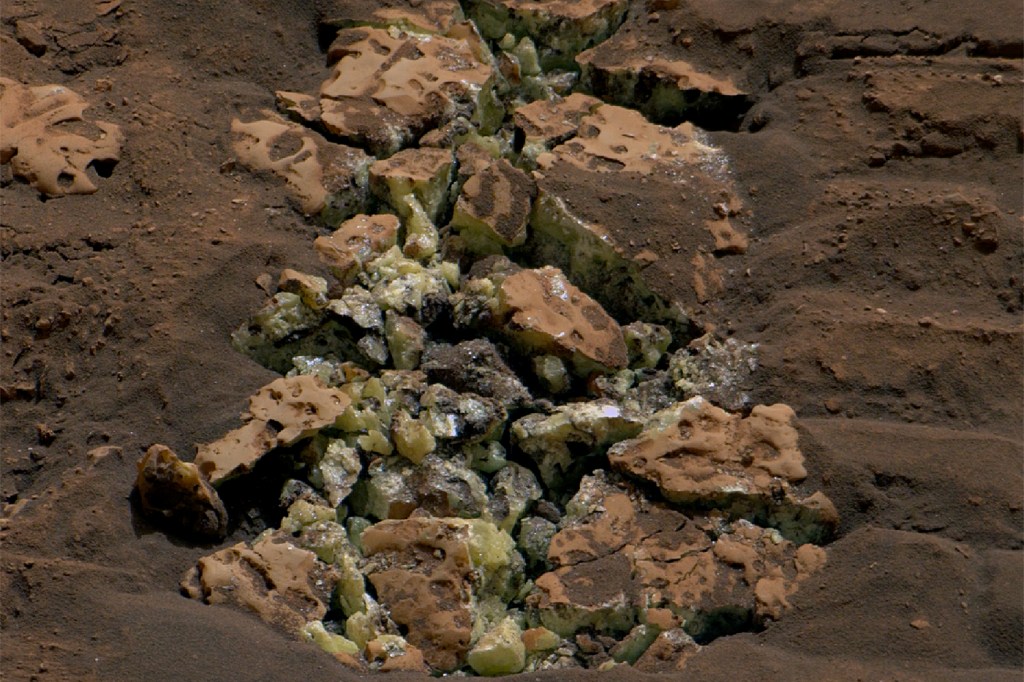Discovery of pure sulfur on Mars might reveal the red planet’s hidden secrets, expert says
The discovery is a monumental geological clue about the planet’s past, Northeastern professor Moneesh Upmanyu says.

It was another workday for Curiosity — a NASA Mars rover — on the cold and lonely red planet, when it crushed another rock under its wheel.
What was found inside stunned NASA scientists. The exposed yellow crystals were pure sulfur, a first for the Mars Science Laboratory mission.
Curiosity had made similar discoveries before, but all were sulfur-based salts left behind as water dried up on this part of Mars billions of years ago.
Although the discovery happened at the end of May, NASA did not reveal this information until July, astonishing the broader scientific community.

“I was shocked,” says Moneesh Upmanyu, a Northeastern University professor of mechanical and industrial engineering and an expert on crystal growth. “Usually sulfur exists as a compound with hydrogen and oxygen.”
Sulfur crystals can be synthesized in a lab, he says, by vaporizing a very saturated solution of sulfur and an organic solvent.
On Earth, sulfur is mined from pure sulfur deposits found in Louisiana, Texas, Canada and Mexico, and it can also be found near high-pressure, high-temperature environments, such as hot springs, volcanoes and hydrothermal vents under the sea where seawater meets magma in the cracks in the seabed. As magma comes out, Upmanyu says, it forms beautiful crystals.
Small forms of life, microorganisms, tend to live around these crystals, because they use minerals for chemosynthesis to produce energy instead of photosynthesis since the sunlight doesn’t reach such depth.
Curiosity reached the planet in August 2012 and set out to determine whether Mars had ever had the right environmental conditions to support microbes. It did find other chemical and mineral evidence of past habitable environments on Mars.
“The big burning question was what Mars was like millions of years ago,” Upmanyu says.
Featured Posts
The sulfur crystals are a very good geological tool, he says, to reconstruct the history of the planet. Scientists might be able to answer a lot of questions, he says, from what the inner core and magma on Mars are like to what happened to the water that made channels and grooves discovered by the science team and rovers.
“If we can conclude that, yes, these sulfur crystals on the surface of Mars were formed by a process like hydrothermal vents or volcanic activity, this is giving us information about the temperature and pressure on Mars at those points [of time] as well as the chemical composition of Mars,” Upmanyu says.
Currently, Mars has a very thin atmosphere that is carbon dioxide rich. The temperature on the red planet ranges from 70 degrees Fahrenheit to -225 degrees Fahrenheit.
“These sulfur crystals may have been formed millions of years ago,” he says. “So we are now able to reconstruct how historically the surface of Mars evolved over time, how temperature evolved, how this planet cooled, what was the chemistry as it cooled.”
On Earth, sulfur is used for rubber vulcanization in the automotive industry to make car tires durable and shock resistant. It is also the main source of sulfates in the skin care industry.
Maybe, Upmanyu says, pure Martian sulfur can be of some use to humans as well.
“I should say sulfur is not so technologically relevant,” he says. “But the possibility exists for other, more technologically relevant pure metal materials to exist there.”












